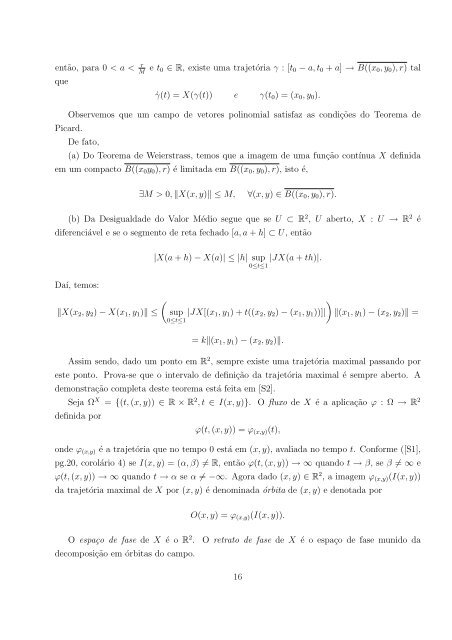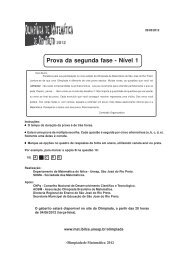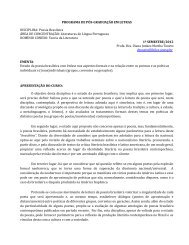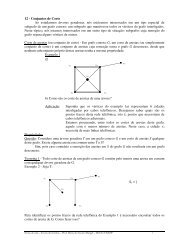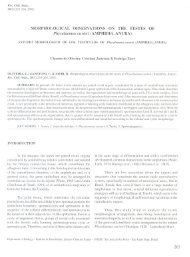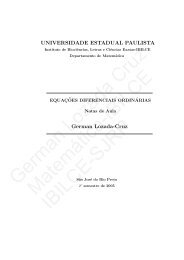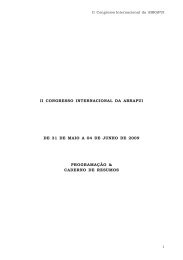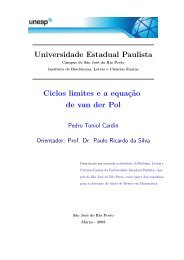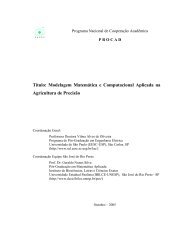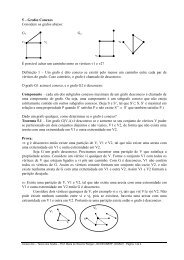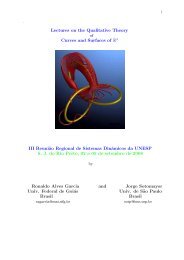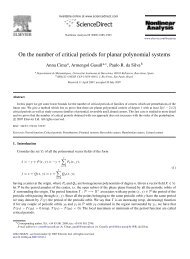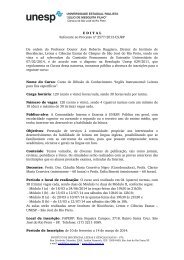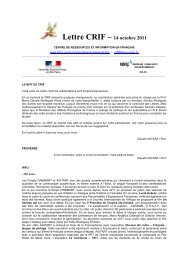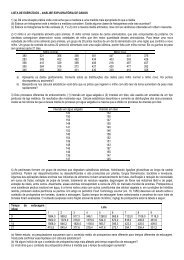Campos de Vetores Polinomiais Planares: Análise ... - Unesp
Campos de Vetores Polinomiais Planares: Análise ... - Unesp
Campos de Vetores Polinomiais Planares: Análise ... - Unesp
You also want an ePaper? Increase the reach of your titles
YUMPU automatically turns print PDFs into web optimized ePapers that Google loves.
então, para 0 < a < r M<br />
que<br />
e t 0 ∈ R, existe uma trajetória γ : [t 0 − a, t 0 + a] → B((x 0 , y 0 ), r) tal<br />
˙γ(t) = X(γ(t)) e γ(t 0 ) = (x 0 , y 0 ).<br />
Observemos que um campo <strong>de</strong> vetores polinomial satisfaz as condições do Teorema <strong>de</strong><br />
Picard.<br />
De fato,<br />
(a) Do Teorema <strong>de</strong> Weierstrass, temos que a imagem <strong>de</strong> uma função contínua X <strong>de</strong>finida<br />
em um compacto B((x 0 y 0 ), r) é limitada em B((x 0 , y 0 ), r), isto é,<br />
∃M > 0, ‖X(x, y)‖ ≤ M,<br />
∀(x, y) ∈ B((x 0 , y 0 ), r).<br />
(b) Da Desigualda<strong>de</strong> do Valor Médio segue que se U ⊂ R 2 , U aberto, X : U → R 2 é<br />
diferenciável e se o segmento <strong>de</strong> reta fechado [a, a + h] ⊂ U, então<br />
Daí, temos:<br />
|X(a + h) − X(a)| ≤ |h| sup |JX(a + th)|.<br />
0≤t≤1<br />
(<br />
)<br />
‖X(x 2 , y 2 ) − X(x 1 , y 1 )‖ ≤ sup |JX[(x 1 , y 1 ) + t((x 2 , y 2 ) − (x 1 , y 1 ))]|<br />
0≤t≤1<br />
‖(x 1 , y 1 ) − (x 2 , y 2 )‖ =<br />
= k‖(x 1 , y 1 ) − (x 2 , y 2 )‖.<br />
Assim sendo, dado um ponto em R 2 , sempre existe uma trajetória maximal passando por<br />
este ponto. Prova-se que o intervalo <strong>de</strong> <strong>de</strong>finição da trajetória maximal é sempre aberto. A<br />
<strong>de</strong>monstração completa <strong>de</strong>ste teorema está feita em [S2].<br />
Seja Ω X = {(t, (x, y)) ∈ R × R 2 , t ∈ I(x, y)}. O fluxo <strong>de</strong> X é a aplicação ϕ : Ω → R 2<br />
<strong>de</strong>finida por<br />
ϕ(t, (x, y)) = ϕ (x,y) (t),<br />
on<strong>de</strong> ϕ (x,y) é a trajetória que no tempo 0 está em (x, y), avaliada no tempo t. Conforme ([S1],<br />
pg.20, corolário 4) se I(x, y) = (α, β) ≠ R, então ϕ(t, (x, y)) → ∞ quando t → β, se β ≠ ∞ e<br />
ϕ(t, (x, y)) → ∞ quando t → α se α ≠ −∞. Agora dado (x, y) ∈ R 2 , a imagem ϕ (x,y) (I(x, y))<br />
da trajetória maximal <strong>de</strong> X por (x, y) é <strong>de</strong>nominada órbita <strong>de</strong> (x, y) e <strong>de</strong>notada por<br />
O(x, y) = ϕ (x,y) (I(x, y)).<br />
O espaço <strong>de</strong> fase <strong>de</strong> X é o R 2 .<br />
<strong>de</strong>composição em órbitas do campo.<br />
O retrato <strong>de</strong> fase <strong>de</strong> X é o espaço <strong>de</strong> fase munido da<br />
16


